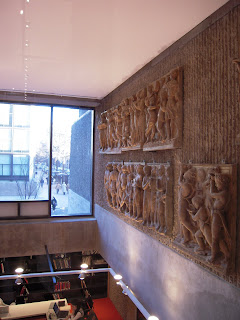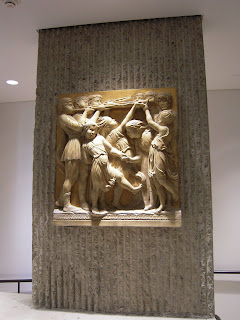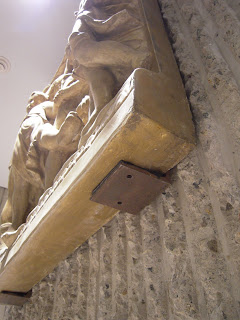With the completion of Yale's Art and Architecture Building restoration, a confrontation between old and new is once more visible to the public. Yale's architecture building was designed by Paul Rudolph in 1959-63 and represents the developments of Brutalism. Best known for its complex section and its rough concrete textures, this building is relentlessly anti-historical. As one walks inside, however, a number of sculptural quotations emerge on the walls. Elijah Huge, who teaches architectural design at Wesleyan University, turned me on to these spolia. Apparently, Rudlolph rampaged through the Yale Art Gallery's cast collection and explicitly chose plaster copies to engage within his brutalist walls. These modern spolia are interesting because of their old-new, smooth-rough juxtaposition, but they also reveal a subtle historical sensibility in high modernism. The very modernist pedagogy that killed the plaster cast has revamped it in the Yale architecture building as an icon. Displaying plaster (the fake) over concrete (the real) creates a dialectical relationship of thesis-antithesis. If we discover the abstract principles underlying the old figurative art, then old and new will be equated and a dialectic synthesis would be achieved. One set of plaster casts includes the Parthenon's Panathenaic frieze. Another highlights Renaissance sculpture. I once sneaked into the "pit," the central studio space, and discovered a colossal plaster statue of Athena watching over the sleepless students.
My friends from Austin asked me to take some photographs of this arrangement, rarely discussed in Rudlolph scholarship. The images were taken this weekend (on Valentine's Day; after a Valentine's Lunch with my wife and daughter at our favorite Asian restaurant)
 Plaster casts hanging on chiseled concrete, overlooking the library space. Louis Kahn's Yale Art Gallery (from which the plaster casts were mined) is seen through the window on the left.
Plaster casts hanging on chiseled concrete, overlooking the library space. Louis Kahn's Yale Art Gallery (from which the plaster casts were mined) is seen through the window on the left. Another dramatic composition of rough and smooth, abstract and figurative.
Another dramatic composition of rough and smooth, abstract and figurative. Detail showing steel clamp holding the plaster attached to the concrete wall.
Detail showing steel clamp holding the plaster attached to the concrete wall. Detail of Caproni Reproductions stamp. Caproni was an Italian workshop that produced plaster casts in Boston. A fabulous order catalog from 1911 is available on line, P. P. Caproni and Brother, Catalog of Plaster Reproductions from Antique, Medieval and Modern Sculpture: Subject for Art Schools (Boston, 1911)
Detail of Caproni Reproductions stamp. Caproni was an Italian workshop that produced plaster casts in Boston. A fabulous order catalog from 1911 is available on line, P. P. Caproni and Brother, Catalog of Plaster Reproductions from Antique, Medieval and Modern Sculpture: Subject for Art Schools (Boston, 1911)An exhibition on Paul Rudolph's work is currently on display inside the renovated building. Model City: Building and Projects by Paul Rudolph was curated by Timothy Rohan (UMass, Amherst). A webcast of Rohan's lecture at the Library of Congress can be seen here. The exhibit highlights other masterpieces in New Haven, like the Temple Street Parking Garage (my favorite garage in the world) and Crawford Manor, which became Robert Venturi's foil to his own Guild House in Learning from Las Vegas (1972). My favorite exhibit was Rudolph's own house in New Haven. Rudolph was dean of architecture at Yale, and in1961 he bought a house on 31 High Street. Rather than raising the building, he preserved the 1850s Italianate structure and added a modernist wing in the rear.
I.m a Plastering Contractor here In Boston MA , I really would love to learn more about this Kind of Plastering work!
ReplyDeleteLook Great!